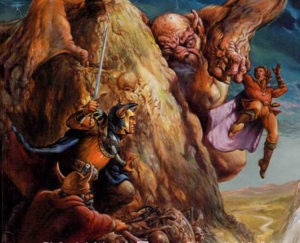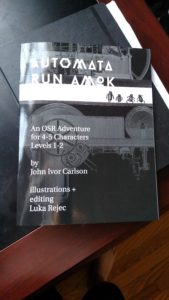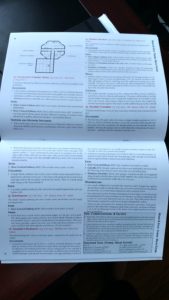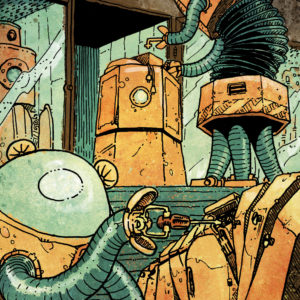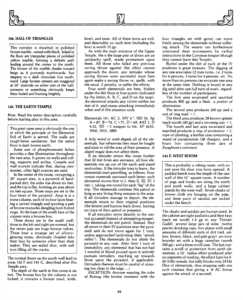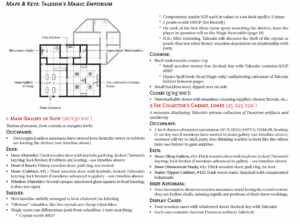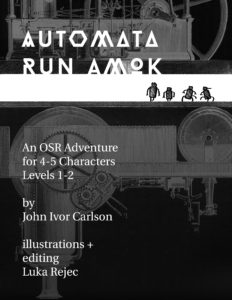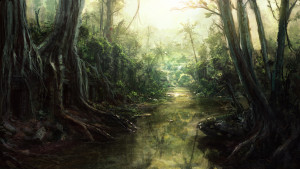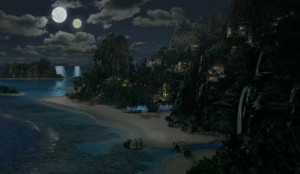
Temple Ruins (Ta Prohm in Cambodia was built by the Khmer King Jayavarman VII as a Mahayana Buddhist monastery and university)
[This is the first post in a series of session summaries (i.e., play reports) for the first campaign I have run in the Curabel setting. Each summary was written by one of the players, but I am adding my own ‘DM Annotations’ on these write-ups before uploading them here. These annotations will mostly call attention to bits of the summaries that will be significant later in the campaign (with links to relevant summaries to follow as they are posted) or else explain my rational for my game-mastering choices.
Please note that the summary will be displayed as regular text and my annotations as block quotes throughout.]
Session 1:
This summary was written by Larry, who plays the dwarf Thorfus. This was fortuitous because his detailed notes set a high standard for subsequent summaries and (I think) inspired the other players to be more observant. He has a blog on old school role-playing at http://followmeanddie.com.
Wednesday, March 19, 2014.
With the exception of a couple of vacations and one or two weeks when there were not enough players for a quorum, we have played every Wednesday for four hours since the campaign’s inception over a year ago. I don’t like cancelling sessions because I want the expectation on the part of players to be that the game is happening regularly and that nothing less than an extraordinary circumstance will keep me from being there. Since I’m not one to harangue players about attendance, this is my way of making the point by example.
Starring:
- James: Sthorm (thief) dwarf
Australian who stayed with the campaign for the first dozen or so sessions. He had some role-playing experience, if I remember correctly, although not necessarily with AD&D 1e.
- Brian: Ir’Alle (cleric) Human
U.S. player with a good bit of RPG experience, although not necessarily old school AD&D. He stayed with the campaign for at least the first twenty sessions and returned for another five or so later on.
- Riese: Galron (paladin) Human
Youngest player who had tried various RPGs, but also had some bad experiences. He is still officially part of the campaign 70+ sessions in, although he hasn’t attended recently since starting college.
- Larry: Thorfus (fighter) dwarf
U.S. player with quite a bit of experience with 1e AD&D (the most in the group). He is still playing and quickly became the closest thing to the party’s leader/caller.
- Antony: Axel (fighter) dwarf
U.K. player with no tabletop RPG experience that is still playing. He quickly picked up good habits, though, and I often forget that he hasn’t been playing for decades.
- Scott/tzx: Uthruk (fighter) half-orc
U.S. player with a good deal of RPG experience who disappeared after the first session. He came back a year later, though, and rejoined with the same character for another dozen or so sessions.
Summary
The hearty adventurers met on a ship going to the island of Midland and its capital and largest city, Midmark.
The hearty adventurers met on a ship: A useful introductory gambit: no one is from the starting location or has unique background knowledge immediately relevant to the campaign (everyone is a greenhorn); not quite the cliché that the tavern meeting is but still provides a logical reason for the party to form – they’re trapped for at least a couple of days on the ship and so talked about their plans in the big city.
We were awakened to what we thought were sailors making ready to dock, but it was actually the crew rescuing the 4 survivors of a wrecked and burning ship. The wrecked ship was attacked by a devil fish not more than an hour before our ship came upon them.
The wrecked ship was attacked by a devil fish: A couple of things here: first, this signals that the world is alive and that things happen even when the party isn’t there to do anything about it. By the time the group arrives, there’s nobody to fight, just miserable people who were victims of some monstrous evil. Second, this foreshadows likely events in the campaign (assuming the party bites on the “starter” dungeon I’ve created) and provides some context for a decision they will need to make there.
After a few more hours we entered the great harbor of the biggest city we had ever seen. The harbor was a forest of masts and rigging and ships of all sizes. The first thing we noticed about the harbor was the smell of tar, giving it the popular name of the Tar-Water.
In the middle of the harbor is an artificial island with foundries belching smoke and dry docks building the ships that make Midland the merchant power of the islands.
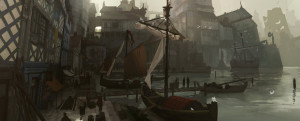
Medieval Port by Kurobo
The docks were packed with people milling, walking and boarding and de-boarding ships. There are huge cranes for loading and offloading cargo. The docks are very high above the water, since with two moons there is a rare double high-tide.
the great harbor … for loading and offloading cargo: I actually wrote out the initial description of the city and its harbor long-hand – this was going to be the base of operations for the party for a while in all likelihood and this was my chance to introduce what was the equivalent of a key NPC. The description itself borrowed heavily from both historical and fictional accounts of Amsterdam during the eighteenth century – especially Neal Stephenson’s work in the novel Quicksilver. As the kind-of sort-of capital of colonial humans in Curabel, who can be described as being like former employees of the world’s Dutch East India Company who became revolutionaries, this seemed appropriate.
docks are very high … rare double high-tide: I did want a little bit of the fantastic to show in the description – although, keeping with my penchant for Gygaxian realism, this expresses itself in terms of how the forces of civilization normalize and assimilate the fantastic in order to function.
A sailor on our ship told us that people at the docks were all the time putting together expeditions to the other islands.
Before we docked, we were met by a boat with one of the customs agents of the Harbor Master, Baswick (something). He told us the rules of the city, which sum up to stay out of trouble, no murder (self-defense is OK), and find work or we will find it for you. We noticed lots of indentured servants on the docks. Baswick then recorded various facts about us, name, where we are from, etc.
He told us the rules … find work: Setting some expectations in game – first, there will be consequences for the characters’ actions; second, the party needs to find something to do (no hand-holding or pre-canned adventure paths here).
We debark to the docks and notice lots of dirty children looking for work.
We asked around and were directed to a grizzled dwarf at a desk by a ship and a tall man next to him. The dwarf, Mortimer, had a golden helm with a built-in eye patch for a missing eye. He was readying an expedition to (the dangerous island). We decided not to sign up and he told us he wouldn’t hire us anyway. We decide to stay local to the island.
The dwarf, Mortimer … wouldn’t hire us anyway: More expectation setting: not every adventure hook is appropriate at every level. If the party had tried to sign-up, they would have had to beat Mortimer’s 5th-level fighter associate in wrestling/grappling. Given the house rules, this is almost (but not quite) impossible. If they had won, I would have let them join the expedition – and they probably would have died very quickly on that “dangerous island”.
We hear of another dwarf, Desric, who sends adventurers locally for dwarven artifacts. There is a hint that he can’t be trusted.
Galron, our paladin, picked out the dirtiest child he could find, who we couldn’t tell if his skin was black or he was just that filthy. Galron gave Efram a gold piece to lead us to Desrick’s. He said it was about an hour into the city. Other boys argued with Efram that he didn’t know the way, etc. Galron made clear we were going with Efram.
Other boys argued with Efram that he didn’t know the way: They said this – they also said not to trust Efram (much like the hint that Desric could not be trusted provided by his business rival, Mortimer). My goal here was to highlight the fact that the party was making a choice and weighing options. I was also showing them that my job wasn’t to tell them what to do or who to trust; they needed to decide based on what their character could see. In this case, they gave the NPC the benefit of the doubt – although they were also on guard for betrayal (which helped them anticipate the ambush mentioned below). Their paranoia has only increased since the beginning of the campaign.
We journeyed N/NW and noticed to the east the town had hills, cathedrals, castles, government buildings, etc. The area where we were had numerous warehouses, narrow streets, and few people.
Unfortunately, Efram appeared to get lost. We soon learned that this was a ploy and that his older brother, Gartric, and some friends had him guide the unwary into a tight street. We did not go down the dead end alley, but met them in an intersection.
Five of them came up to us demanding gold, thinking we were rich. We refused and battle ensued. We dropped three of them and the last two surrendered, but fled at mention of the constable. We patched up the wounded thieves, Galron healed the leader who we soon learned was Efram’s brother.
We patched up the wounded thieves: This turned out to be a serendipitous opportunity to show the group how their actions would have consequences. They could have simply killed the bandits, but instead made sure they would live (even leaving them at a temple for care and healing). Later, when the group’s thief, Sthorm, needed training, the gang/guild these ruffians belonged to would know about the group and have a better opinion of them because of these actions. Instead of making an enemy of “Cutter’s Mad-dogs,” they had a potential ally and resource.
We learned that there was a great canal running through the city, and there are only a few bridges where it can be crossed.
We encountered another shrine of the Ark and a cleric was present. We were all healed for some of our damage. The note entitled us to free healing for a service to the Ark. Normally, there would have been an expected donation.
The note entitled us…: This was an even more immediate consequence for the group’s merciful actions – which also happened to get healing to a low-level group with limited resources.
We finally reach Desric’s. It looked like a junk yard, with ancient dwarven artifacts in various states. Across from it is the Cock & Bull inn & tavern. We banged on the door until Desric let us in, it was early, but other businesses were open. He place was fulls of bits and pieces and lots of books. He told us he got word of an emergency at Talisin’s place. He told us that he was too old and tired to go out in the middle of the night. Desric said that Talisin was doing dangerous things and shouldn’t be meddling with what he was. Desric offered us 50 gold to bring him papers that explained the ancient dwarven automata that he was working with.
Desric offered us 50 gold…: Here is the introductory adventure’s hook – some quick money for looking into some shady business across town. It also introduces the first hint of politics of the world (in this case within the Tinkerers’ Guild) and the fact that there is quite a bit of interest in recovering and messing around with ancient doodads.
Desric told us that Talisin would probably be found at the Lucky Gam, if he was not at his place. He gave us directions to the Lucky Gam.
We find the tavern, and Talisin and two of his three students were with him. The missing student, Osric, has not been seen since last night.
Talisin explained that he and Desric are member’s of the Tinkerer’s Guild and that Talisin is secretary and that Desric wants his office. Talisin has hopes of doing something wondrous with the automatons and becoming president of the guild. We get the impression that Talisin is more honorable and tell him what Descric wanted. Talisin offers us 150 gold (was that right?) for each automaton that is not destroyed.
Talisin explained …: The party is now coming to expect that the initial story isn’t always the whole story and that they need to make judgement calls (see the Efram bit above). They are completely wrong here, but they’re at least being thoughtful (and trying to play NPCs against one another to get a better deal – a fine and profitable art in itself).
What happened is that he built three monkey creatures and two dwarven warrior [automata] without issue. The automaton he was working on last night needed one final piece. Often he has custom pieces made. This one was a custom piece and when put in place the automaton took over the others, he called it an Overseer. He said that if we removed the circlet from its dome, it would cease to control the others. Talisin said that it was directing the others to build more automatons.
This one was a custom piece … to build more automatons: I thought this was suitably unconventional, obviously worth the party’s time, but not too overwhelming “quest”. It also further added to the foreshadowing and preparation for the “starter”’ dungeon and what they would encounter there.
He gave us the key to his place. We explored his shop front and the lower level of the tower, then made our way up the stairs. We encountered a monkey creature in one room and it threw acid at us. Thorfus was the only one hit, but water stopped the acid from doing more damage. The rooms had no ceiling, so the monkey came over the wall, but did not follow us when we went through double doors that took us in to a workshop.
The rooms had no ceiling: It’s not so clear in the summary, but I wanted to make the first “adventure” location tactically interesting. Therefore, I imagined a multi-room workshop with ten-foot walls but a 30’ ceiling above all those smaller spaces. Above the walls was a metal walkway that Talissen would have used to watch his apprentices while they worked below without needing to go into each workshop room. Now, though, this openness became a tactical challenge when fighting mechanical monkeys that could climb the walls and gangway and throw acid.
We heard noise on the other side of the door, but as soon as we entered the noise of work stopped and we were faced with a monkey creature and a dwarven automaton. We could tell the monkey had been trying to put some gears together.
dwarven automaton: In this context, a automaton shaped like a dwarven warrior but taller (just a bit more than man-sized).
We tried to run past the dwarven automaton, some of the party made it, but Thorfus was hit and went down. Others in the party attacked. I believe it was Sthorm that hit the dwarven machine for a little damage, but Uthruk jumped off the gangway above us and hit it for enough damage that it stopped attacking, Galron lept down and grappled with the monkey creature and others helped him tie it up with wire that was there. Ir’Alle came to Thorfus’s aid and cast cure light wounds.
Uthruk jumped off the gangway … Galron lept down and grappled: This was a fortuitous event, as well. The first player, Scott, described what he wanted to do even though there were no clear 1e rules for “jump down off a gangway to stab an enemy.” We talked about it, though, and decided this would be a kind-of charge except that Uthruk would face more dire circumstances (being prone, fall damage, etc.) if he failed to hit. It worked, showing the group that creative thinking would be rewarded and that we would negotiate resolution mechanics for situations the books didn’t cover rather than artificially limit choices. This immediately inspired Riese (playing Galron) to try the grapple maneuver described next and many similar events in subsequent sessions.
Play then ceased for the night just after midnight.
A glorious time was had by all and we can’t wait to continue the adventure next week.



